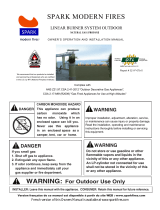
www.fmiproducts.com
126417-01C2
TABLE OF CONTENTS
Safety .................................................................. 2
Local Codes......................................................... 4
Product identication ........................................... 4
Product Features ................................................. 4
Installation ........................................................... 5
Operation ........................................................... 16
Cleaning and Maintenance ................................ 18
Inspecting Burners............................................. 19
Replacing Light Bulb.......................................... 19
Wiring Diagram .................................................. 20
Troubleshooting ................................................. 21
Parts .................................................................. 24
Specications .................................................... 27
Replacement Parts ............................................ 27
Service Hints ..................................................... 27
Technical Service............................................... 27
Accessories ....................................................... 27
Warranty ..............................................Back Cover
SAFETY
WARNING: Improper
installation, adjustment,
alteration, service or
maintenance can cause
injury or property dam-
age. Refer to this manual
for correct installation
and operational proce-
dures. For assistance or
additional information
consult a qualified in-
staller, service agency or
the gas supplier.
* Aftermarket: Completion of sale, not for
purpose of resale, from the manufacturer
WARNING: This product
contains and/or generates
chemicals known to the State
of California to cause cancer or
birth defects or other reproduc-
tive harm.
IMPORTANT: Read this owner’s
manual carefully and completely
before trying to assemble, op-
erate or service this replace.
Improper use of this replace
can cause serious injury or
death from burns, re, explo-
sion, electrical shock and carbon
monoxide poisoning.
DANGER: Carbon monoxide
poisoning may lead to death!
Carbon Monoxide Poisoning: Early signs of
carbon monoxide poisoning resemble the u,
with headaches, dizziness or nausea. If you
have these signs, the replace may not be
working properly. Get fresh air at once! Have
heater serviced. Some people are more af-
fected by carbon monoxide than others. These
include pregnant women, people with heart
or lung disease or anemia, those under the
inuence of alcohol and those at high altitudes.
Natural and Propane/LP Gas: Natural and
propane/LP gases are odorless. An odor-
making agent is added to the gas. The odor
helps you detect a gas leak. However, the
odor added to the gas can fade. Gas may be
present even though no odor exists.
Make certain you read and understand all
warnings. Keep this manual for reference. It
is your guide to safe and proper operation of
this
replace
.
WARNING: Any change to
this replace or its controls can
be dangerous.
Due to high temperatures, the
appliance should be located out
of trafc and away from furniture
and draperies.
Do not place clothing or other
ammable material on or near
the appliance. Never place any
objects on the replace.


























